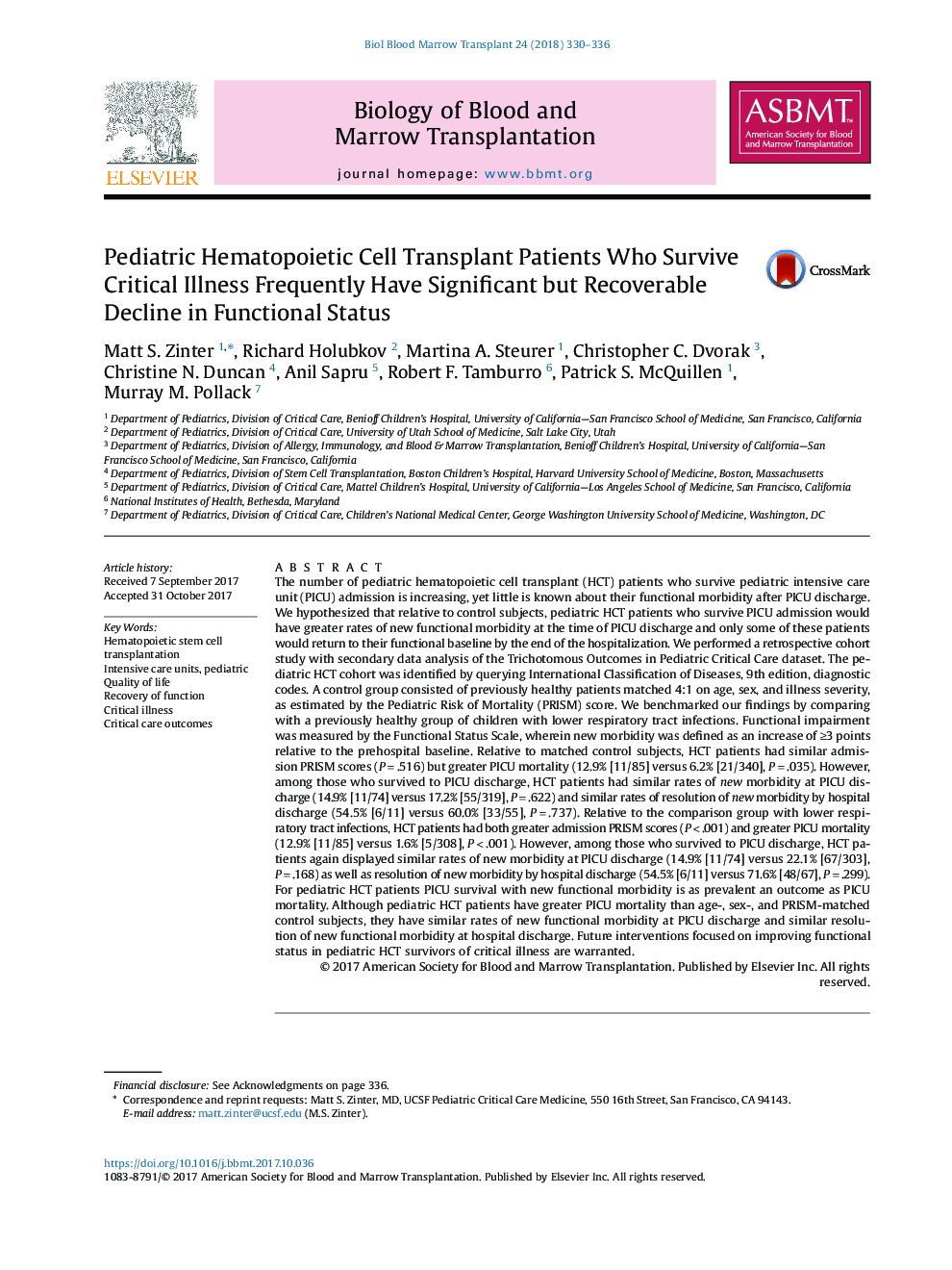| کد مقاله | کد نشریه | سال انتشار | مقاله انگلیسی | نسخه تمام متن |
|---|---|---|---|---|
| 8430336 | 1546232 | 2018 | 7 صفحه PDF | دانلود رایگان |
عنوان انگلیسی مقاله ISI
Pediatric Hematopoietic Cell Transplant Patients Who Survive Critical Illness Frequently Have Significant but Recoverable Decline in Functional Status
ترجمه فارسی عنوان
بیماران پیوند سلول های هماتوپیتی کودکان که از بیماری های بحرانی رنج می برند، اغلب کاهش قابل توجه و قابل بازیابی در وضعیت عملکردی دارند
دانلود مقاله + سفارش ترجمه
دانلود مقاله ISI انگلیسی
رایگان برای ایرانیان
کلمات کلیدی
پیوند سلول بنیادی هماتوپوئیت، واحد مراقبت های ویژه، اطفال، کیفیت زندگی، بازیابی عملکرد بیماری بحرانی، نتایج مراقبت های ویژه،
موضوعات مرتبط
علوم زیستی و بیوفناوری
بیوشیمی، ژنتیک و زیست شناسی مولکولی
تحقیقات سرطان
چکیده انگلیسی
The number of pediatric hematopoietic cell transplant (HCT) patients who survive pediatric intensive care unit (PICU) admission is increasing, yet little is known about their functional morbidity after PICU discharge. We hypothesized that relative to control subjects, pediatric HCT patients who survive PICU admission would have greater rates of new functional morbidity at the time of PICU discharge and only some of these patients would return to their functional baseline by the end of the hospitalization. We performed a retrospective cohort study with secondary data analysis of the Trichotomous Outcomes in Pediatric Critical Care dataset. The pediatric HCT cohort was identified by querying International Classification of Diseases, 9th edition, diagnostic codes. A control group consisted of previously healthy patients matched 4:1 on age, sex, and illness severity, as estimated by the Pediatric Risk of Mortality (PRISM) score. We benchmarked our findings by comparing with a previously healthy group of children with lower respiratory tract infections. Functional impairment was measured by the Functional Status Scale, wherein new morbidity was defined as an increase of â¥3 points relative to the prehospital baseline. Relative to matched control subjects, HCT patients had similar admission PRISM scores (Pâ=â.516) but greater PICU mortality (12.9% [11/85] versus 6.2% [21/340], Pâ=â.035). However, among those who survived to PICU discharge, HCT patients had similar rates of new morbidity at PICU discharge (14.9% [11/74] versus 17.2% [55/319], Pâ=â.622) and similar rates of resolution of new morbidity by hospital discharge (54.5% [6/11] versus 60.0% [33/55], Pâ=â.737). Relative to the comparison group with lower respiratory tract infections, HCT patients had both greater admission PRISM scores (Pâ<â.001) and greater PICU mortality (12.9% [11/85] versus 1.6% [5/308], Pâ<â.001). However, among those who survived to PICU discharge, HCT patients again displayed similar rates of new morbidity at PICU discharge (14.9% [11/74] versus 22.1% [67/303], Pâ=â.168) as well as resolution of new morbidity by hospital discharge (54.5% [6/11] versus 71.6% [48/67], Pâ=â.299). For pediatric HCT patients PICU survival with new functional morbidity is as prevalent an outcome as PICU mortality. Although pediatric HCT patients have greater PICU mortality than age-, sex-, and PRISM-matched control subjects, they have similar rates of new functional morbidity at PICU discharge and similar resolution of new functional morbidity at hospital discharge. Future interventions focused on improving functional status in pediatric HCT survivors of critical illness are warranted.
ناشر
Database: Elsevier - ScienceDirect (ساینس دایرکت)
Journal: Biology of Blood and Marrow Transplantation - Volume 24, Issue 2, February 2018, Pages 330-336
Journal: Biology of Blood and Marrow Transplantation - Volume 24, Issue 2, February 2018, Pages 330-336
نویسندگان
Matt S. Zinter, Richard Holubkov, Martina A. Steurer, Christopher C. Dvorak, Christine N. Duncan, Anil Sapru, Robert F. Tamburro, Patrick S. McQuillen, Murray M. Pollack,
